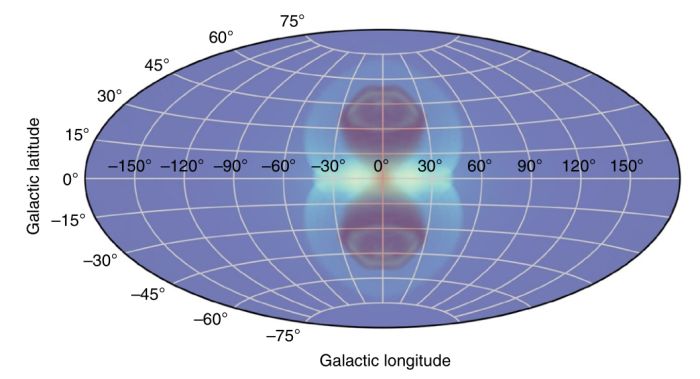Two sets of giant bubbles that extend thousands of light-years above and below the plane of the Milky Way could have been produced by the same event, in spite of their significant difference in size.
They’re called the Fermi bubbles and the eROSITA bubbles, and astronomers believe they were the result of activity by the supermassive black hole in the center of the Milky Way, Sagittarius A*. Since one set of bubbles is much bigger than the other, it hasn’t been clear if they were produced at the same time, or by separate events.
The Fermi bubbles, detected in 2010 and filled with hot gas and magnetic fields that emit gamma radiation, extend nine kiloparsecs (29,354 light-years) above and below the galactic plane, for a total size of 18 kiloparsecs. They also have a microwave counterpart, referred to as the microwave haze.
The eROSITA bubbles, emitting X-radiation, extend around 14 kiloparsecs (45,661 light-years) in either direction from the galactic center, for a total of 28 kiloparsecs. At that size, they engulf the Fermi bubbles entirely.
Yet, from even before the full extent of the eROSITA bubbles was discovered, detailed in a 2020 paper, scientists thought it was likely they were produced by the same outburst. The two sets of bubbles have remarkably similar shapes, suggesting that they are connected in some way.
Because the bubbles are emitted from the galactic center, and because similar bubbles have been seen in other galaxies, it seems likely that the Fermi and eROSITA bubbles are related to Sgr A*, rather than a heightened period of star formation, known as starburst.
A team of astronomers led by Hsiang-Yi Karen Yang of National Tsing Hua University in Taiwan has used numerical simulations to narrow down the supermassive black hole activity that could produce the bubbles as we see them. Choosing from two possible phenomena – giant winds blowing from Sgr A*, or astrophysical jets – the researchers found that astrophysical jets are more plausible.
“Before the detection of the eROSITA bubbles, the physical origin of the Fermi bubbles and microwave haze had been hotly debated,” they write in their paper.
“We show that the new eROSITA data provide crucial information that allows us to put additional constraints on these two scenarios, and that the combination of the gamma-ray, X-ray and microwave images and spectra strongly suggest that past jet activity of the galactic center black hole is the likely culprit.”
Sgr A* is pretty quiet now, emitting only the occasional outburst. It’s not what we classify as an active galactic nucleus; that’s a galactic supermassive black hole that is actively feeding on material from a huge cloud around it. This is a messy process, with different kinds of outflows.
The space around a black hole gets very complicated. Material feeds into the black hole from an accretion disk of material that swirls around it, much like water swirls around a drain. It’s thought that these jets are produced from a small fraction of material that gets funneled along magnetic field lines outside the event horizon, from the inner region of the accretion disk.
The magnetic field lines act as a synchrotron, accelerating this material to the black hole’s polar regions, where it is blasted into space in the form of incredibly fast jets of ionized plasma. These jets can blow quite a distance into the space above and below the galactic plane.
The simulation by Yang and her team assumed that Sgr A* was active around 2.6 million years ago, blasting jets into space for approximately 100,000 years, pushing into the interstellar medium of the galactic halo.
These assumptions neatly reproduced sets of bubbles very similar to the observed Fermi and eROSITA bubbles.
 The simulation, with gamma-ray bubbles in purple and X-ray in blue. (Yang et al., Nat. Astron., 2022)
The simulation, with gamma-ray bubbles in purple and X-ray in blue. (Yang et al., Nat. Astron., 2022)
The large pressure contrast between the jets and the ambient gas of the interstellar medium caused the jets to expand into a pair of ‘cocoons’ or ‘bubbles’, similar to radio bubbles observed in galaxy clusters, the researchers found.
“At the present day, the cocoons have grown and reached a height of ~7.5 kiloparsecs from the Galactic plane. The cosmic ray electrons within the cocoons that were transported from the galactic center interact with the interstellar radiation field and shine in the gamma-ray band as the observed Fermi bubbles,” they write in their paper.
“The same energy injection from the black hole and subsequent cocoon expansion pushed the gas within the galactic halo away from the galactic halo with supersonic speeds, forming an outward propagating shock. At the shock front, the compression of gas caused an increase in the local gas density, producing enhanced thermal Bremsstrahlung (braking) emission in the X-ray band manifested as the eROSITA bubbles.”
Due to high levels of dust, the galactic center is very hard to see into. If the bubbles were produced by jets around 2.6 million years ago, this gives us some clues as to its history. The team’s model suggests that magnetic fields and radiation were suppressed at the time the jets were launched. Exploring the mechanisms whereby this could have occurred may be the subject of a future analysis.
“Future investigations will further reveal the impact of this energetic feedback on the evolution history of our Milky Way Galaxy,” the researchers write, “and how this event fits in the broader picture of supermassive black hole–galaxy co-evolution in the Universe.”
The research has been published in Nature Astronomy.
